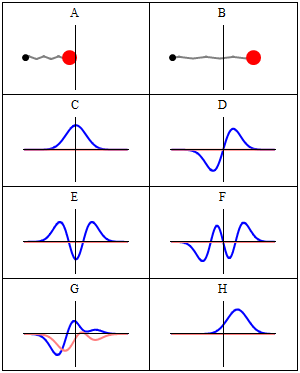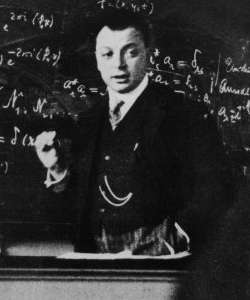|
Propagator
In quantum mechanics and quantum field theory, the propagator is a function that specifies the probability amplitude for a particle to travel from one place to another in a given period of time, or to travel with a certain energy and momentum. In Feynman diagrams, which serve to calculate the rate of collisions in quantum field theory, virtual particles contribute their propagator to the rate of the scattering event described by the respective diagram. Propagators may also be viewed as the inverse of the wave operator appropriate to the particle, and are, therefore, often called ''(causal) Green's functions'' (called "''causal''" to distinguish it from the elliptic Laplacian Green's function). Non-relativistic propagators In non-relativistic quantum mechanics, the propagator gives the probability amplitude for a particle to travel from one spatial point (x') at one time (t') to another spatial point (x) at a later time (t). The Green's function G for the Schrödinger equat ... [...More Info...] [...Related Items...] OR: [Wikipedia] [Google] [Baidu] |
Mehler Kernel
The Mehler kernel is a complex-valued function found to be the propagator of the quantum harmonic oscillator. It was first discovered by Mehler in 1866, and since then, as Einar Hille remarked in 1932, "has been rediscovered by almost everybody who has worked in this field". Mehler's formula defined a function and showed, in modernized notation, that it can be expanded in terms of Hermite polynomials H(\cdot) based on weight function \exp(-x^2) as :E(x,y) = \sum_^\infty \frac ~ \mathit_n(x)\mathit_n(y) ~. This result is useful, in modified form, in quantum physics, probability theory, and harmonic analysis. Physics version In physics, the fundamental solution, (Green's function), or propagator of the Hamiltonian for the quantum harmonic oscillator is called the Mehler kernel. It provides the fundamental solution \varphi(x,t) to :\frac = \frac-x^2\varphi \equiv D_x \varphi ~. The orthonormal eigenfunctions of the operator D are the Hermite functions, :\psi_n = \frac, ... [...More Info...] [...Related Items...] OR: [Wikipedia] [Google] [Baidu] |
Path Integral Formulation
The path integral formulation is a description in quantum mechanics that generalizes the stationary action principle of classical mechanics. It replaces the classical notion of a single, unique classical trajectory for a system with a sum, or functional integral, over an infinity of quantum-mechanically possible trajectories to compute a quantum amplitude. This formulation has proven crucial to the subsequent development of theoretical physics, because manifest Lorentz covariance (time and space components of quantities enter equations in the same way) is easier to achieve than in the operator formalism of canonical quantization. Unlike previous methods, the path integral allows one to easily change coordinates between very different canonical descriptions of the same quantum system. Another advantage is that it is in practice easier to guess the correct form of the Lagrangian of a theory, which naturally enters the path integrals (for interactions of a certain type, these ... [...More Info...] [...Related Items...] OR: [Wikipedia] [Google] [Baidu] |
Green's Function
In mathematics, a Green's function (or Green function) is the impulse response of an inhomogeneous linear differential operator defined on a domain with specified initial conditions or boundary conditions. This means that if L is a linear differential operator, then * the Green's function G is the solution of the equation where \delta is Dirac's delta function; * the solution of the initial-value problem L y = f is the convolution Through the superposition principle, given a linear ordinary differential equation (ODE), one can first solve for each , and realizing that, since the source is a sum of delta functions, the solution is a sum of Green's functions as well, by linearity of . Green's functions are named after the British mathematician George Green, who first developed the concept in the 1820s. In the modern study of linear partial differential equations, Green's functions are studied largely from the point of view of fundamental solutions instead. Under many ... [...More Info...] [...Related Items...] OR: [Wikipedia] [Google] [Baidu] |
Green's Function (many-body Theory)
In many-body theory, the term Green's function (or Green function) is sometimes used interchangeably with correlation function, but refers specifically to correlators of field operators or creation and annihilation operators. The name comes from the Green's functions used to solve inhomogeneous differential equations, to which they are loosely related. (Specifically, only two-point "Green's functions" in the case of a non-interacting system are Green's functions in the mathematical sense; the linear operator that they invert is the Hamiltonian operator, which in the non-interacting case is quadratic in the fields.) Spatially uniform case Basic definitions We consider a many-body theory with field operator (annihilation operator written in the position basis) \psi(\mathbf). The Heisenberg operators can be written in terms of Schrödinger operators as \psi(\mathbf,t) = e^ \psi(\mathbf) e^, and the creation operator is \bar\psi(\mathbf,t) = psi(\mathbf,t)\dagger, where K = ... [...More Info...] [...Related Items...] OR: [Wikipedia] [Google] [Baidu] |
Wave Packet
In physics, a wave packet (also known as a wave train or wave group) is a short burst of localized wave action that travels as a unit, outlined by an Envelope (waves), envelope. A wave packet can be analyzed into, or can be synthesized from, a potentially-infinite set of component sinusoidal waves of different wavenumbers, with phases and amplitudes such that they interfere constructively only over a small region of space, and destructively elsewhere. Any signal of a limited width in time or space requires many frequency components around a center frequency within a Bandwidth (signal processing), bandwidth inversely proportional to that width; even a gaussian function is considered a wave packet because its Fourier transform is a "packet" of waves of frequencies clustered around a central frequency. Each component wave function, and hence the wave packet, are solutions of a wave equation. Depending on the wave equation, the wave packet's profile may remain constant (no #Non-dispe ... [...More Info...] [...Related Items...] OR: [Wikipedia] [Google] [Baidu] |
Feynman Diagram
In theoretical physics, a Feynman diagram is a pictorial representation of the mathematical expressions describing the behavior and interaction of subatomic particles. The scheme is named after American physicist Richard Feynman, who introduced the diagrams in 1948. The calculation of probability amplitudes in theoretical particle physics requires the use of large, complicated integrals over a large number of variables. Feynman diagrams instead represent these integrals graphically. Feynman diagrams give a simple visualization of what would otherwise be an arcane and abstract formula. According to David Kaiser, "Since the middle of the 20th century, theoretical physicists have increasingly turned to this tool to help them undertake critical calculations. Feynman diagrams have revolutionized nearly every aspect of theoretical physics." While the diagrams apply primarily to quantum field theory, they can be used in other areas of physics, such as solid-state theory. Frank Wi ... [...More Info...] [...Related Items...] OR: [Wikipedia] [Google] [Baidu] |
Quantum Harmonic Oscillator
The quantum harmonic oscillator is the quantum-mechanical analog of the classical harmonic oscillator. Because an arbitrary smooth potential can usually be approximated as a harmonic potential at the vicinity of a stable equilibrium point, it is one of the most important model systems in quantum mechanics. Furthermore, it is one of the few quantum-mechanical systems for which an exact, analytical solution is known. One-dimensional harmonic oscillator Hamiltonian and energy eigenstates The Hamiltonian of the particle is: \hat H = \frac + \frac k ^2 = \frac + \frac m \omega^2 ^2 \, , where is the particle's mass, is the force constant, \omega = \sqrt is the angular frequency of the oscillator, \hat is the position operator (given by in the coordinate basis), and \hat is the momentum operator (given by \hat p = -i \hbar \, \partial / \partial x in the coordinate basis). The first term in the Hamiltonian represents the kinetic energy of the particle, and the second ... [...More Info...] [...Related Items...] OR: [Wikipedia] [Google] [Baidu] |
Wolfgang Pauli
Wolfgang Ernst Pauli ( ; ; 25 April 1900 – 15 December 1958) was an Austrian theoretical physicist and a pioneer of quantum mechanics. In 1945, after having been nominated by Albert Einstein, Pauli received the Nobel Prize in Physics "for the discovery of the Exclusion Principle, also called the Pauli exclusion principle, Pauli Principle". The discovery involved Spin (physics), spin theory, which is the basis of a theory of the Matter#Structure, structure of matter. To preserve the conservation of energy in beta decay, he posited the existence of a small neutral particle, dubbed the neutrino by Enrico Fermi. The neutrino was detected in 1956. Early life Pauli was born in Vienna to a chemist, (''né'' Wolf Pascheles, 1869–1955), and his wife, Bertha Camilla Schütz; his sister was Hertha Pauli, a writer and actress. Pauli's middle name was given in honor of his Godparent, godfather, physicist Ernst Mach. Pauli's paternal grandparents were from prominent Jewish families of ... [...More Info...] [...Related Items...] OR: [Wikipedia] [Google] [Baidu] |
Quantum Field Theory
In theoretical physics, quantum field theory (QFT) is a theoretical framework that combines Field theory (physics), field theory and the principle of relativity with ideas behind quantum mechanics. QFT is used in particle physics to construct physical models of subatomic particles and in condensed matter physics to construct models of quasiparticles. The current standard model of particle physics is based on QFT. History Quantum field theory emerged from the work of generations of theoretical physicists spanning much of the 20th century. Its development began in the 1920s with the description of interactions between light and electrons, culminating in the first quantum field theory—quantum electrodynamics. A major theoretical obstacle soon followed with the appearance and persistence of various infinities in perturbative calculations, a problem only resolved in the 1950s with the invention of the renormalization procedure. A second major barrier came with QFT's apparent inabili ... [...More Info...] [...Related Items...] OR: [Wikipedia] [Google] [Baidu] |
Canonical Commutation Relation
In quantum mechanics, the canonical commutation relation is the fundamental relation between canonical conjugate quantities (quantities which are related by definition such that one is the Fourier transform of another). For example, hat x,\hat p_x= i\hbar \mathbb between the position operator and momentum operator in the direction of a point particle in one dimension, where is the commutator of and , is the imaginary unit, and is the reduced Planck constant , and \mathbb is the unit operator. In general, position and momentum are vectors of operators and their commutation relation between different components of position and momentum can be expressed as hat x_i,\hat p_j= i\hbar \delta_, where \delta_ is the Kronecker delta. This relation is attributed to Werner Heisenberg, Max Born and Pascual Jordan (1925), who called it a "quantum condition" serving as a postulate of the theory; it was noted by E. Kennard (1927) to imply the Heisenberg uncertainty principle. The St ... [...More Info...] [...Related Items...] OR: [Wikipedia] [Google] [Baidu] |
Relativistic Quantum Mechanics
In physics, relativistic quantum mechanics (RQM) is any Poincaré- covariant formulation of quantum mechanics (QM). This theory is applicable to massive particles propagating at all velocities up to those comparable to the speed of light ''c'', and can accommodate massless particles. The theory has application in high-energy physics, particle physics and accelerator physics, as well as atomic physics, chemistry and condensed matter physics. ''Non-relativistic quantum mechanics'' refers to the mathematical formulation of quantum mechanics applied in the context of Galilean relativity, more specifically quantizing the equations of classical mechanics by replacing dynamical variables by operators. ''Relativistic quantum mechanics'' (RQM) is quantum mechanics applied with special relativity. Although the earlier formulations, like the Schrödinger picture and Heisenberg picture were originally formulated in a non-relativistic background, a few of them (e.g. the Dirac or path-i ... [...More Info...] [...Related Items...] OR: [Wikipedia] [Google] [Baidu] |




